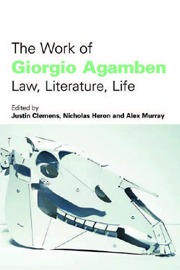Book contents
- Frontmatter
- Contents
- Acknowledgements
- Notes on Contributors
- The Enigma of Giorgio Agamben
- 1 K
- 2 Integral Actuality: On Giorgio Agamben's Idea of Prose
- 3 The Role of the Shifter and the Problem of Reference in Giorgio Agamben
- 4 ‘Its Silent Working was a Delusion’
- 5 Politics and Poetics of Divine Violence: On a Figure in Giorgio Agamben and Walter Benjamin
- 6 Idea of Poetry, Idea of Prose
- 7 The Fading Memory of Homo non Sacer
- 8 Soulblind, or On Profanation
- 9 Face to Face with Agamben; or, the Other in Love
- 10 Beyond Spectacle and the Image: the Poetics of Guy Debord and Agamben
- 11 Dismantling Theatricality: Aesthetics of Bare Life
- 12 Notes on Media and Biopolitics: ‘Notes on Gesture’
- Index
4 - ‘Its Silent Working was a Delusion’
Published online by Cambridge University Press: 12 September 2012
- Frontmatter
- Contents
- Acknowledgements
- Notes on Contributors
- The Enigma of Giorgio Agamben
- 1 K
- 2 Integral Actuality: On Giorgio Agamben's Idea of Prose
- 3 The Role of the Shifter and the Problem of Reference in Giorgio Agamben
- 4 ‘Its Silent Working was a Delusion’
- 5 Politics and Poetics of Divine Violence: On a Figure in Giorgio Agamben and Walter Benjamin
- 6 Idea of Poetry, Idea of Prose
- 7 The Fading Memory of Homo non Sacer
- 8 Soulblind, or On Profanation
- 9 Face to Face with Agamben; or, the Other in Love
- 10 Beyond Spectacle and the Image: the Poetics of Guy Debord and Agamben
- 11 Dismantling Theatricality: Aesthetics of Bare Life
- 12 Notes on Media and Biopolitics: ‘Notes on Gesture’
- Index
Summary
A cage went in search of a bird.
Franz KafkaIn his short story ‘In the Penal Settlement’, Franz Kafka describes a machine, ‘the apparatus’, in which a condemned man is to be executed. This apparatus – as lovingly described by the officer who supervises it – works in the following way. Firstly, the condemned man is laid naked on a bed, stomach down; next, he is strapped in by his hands, feet and throat, while a piece of felt is stuffed into his mouth ‘to keep him from screaming and biting his tongue’. Above the bed is the inscriber and, attached to that, the harrow – a word that refers not only to the sharp teeth of the ploughing instrument it resembles, but also to the distress and torment it produces. Once the condemned man is firmly strapped in, the work of sentencing begins. While the idea that a sentence would be produced by the same machine that is to carry out the punishment seems unusual, this blurring of sentence and punishment, judgement and execution is precisely what is at stake in Kafka's story. When the machine kills a man, it does so by inscribing a sentence – in this case, the sentence is Honour Your Superiors – onto his body, writing deeper and deeper into the flesh, until, after approximately twelve hours, the man is killed.
In Idea of Prose, Giorgio Agamben discusses Kafka's story in order to illuminate the ambiguity whereby the linguistic sentence blurs into the penal sentence. What Kafka reveals, Agamben suggests, is that the machine of torture in the penal colony is language. The apparatus, Agamben suggests, ‘is primarily a machine of justice and punishment. This means that on earth and for men, language is also such an instrument.’
- Type
- Chapter
- Information
- The Work of Giorgio AgambenLaw Literature Life, pp. 66 - 81Publisher: Edinburgh University PressPrint publication year: 2008



